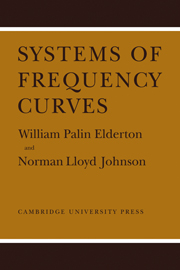6 - CURVES REPRESENTED BY SERIES EXPANSIONS
Published online by Cambridge University Press: 05 May 2010
Summary
1. In the previous chapter we dealt with Pearson's system of frequency curves, but other methods have been used to describe frequency distributions. We have already seen that Pearson's system of curves describes the facts that have been collected about a variety of subjects connected with chance. A system is useless if it does not give approximately the distributions that actually occur. The binomial series is justified from this point of view as a description of the number of times events happen, because we have found from experience that the numbers given by it are realized approximately by trial. When we consider the matter we are almost compelled to admit that the real justification of any theory of probability is that events happen in the way such a theory leads one to expect, and if we wish to compare the systems of frequency curves that have been suggested in recent years, it should be done not so much by examining the ways in which they have been derived as by seeing what classes of distribution they represent and by noticing carefully the cases of failure and the difficulties of application.
2. As we know from experience that the binomial series actually represents a simple type of probability, it is natural to start from it and treat it, or its limits, as a part of any system; it must, in fact, be a special case of any more general type that may be evolved.
- Type
- Chapter
- Information
- Systems of Frequency Curves , pp. 110 - 121Publisher: Cambridge University PressPrint publication year: 1969

